Although I am not an art critic, I can confidently say that the paintings in Bundi Chitrashala are ancient masterpieces. They exude a distinct charm with bright colors, intricate details, and storytelling themes that seem to come alive. The Bundi painters didn’t just create decorative art; they crafted narratives with a flair that could rival modern graphic novels.
I have traveled to all the major Rajasthani destinations, i.e., Udaipur, Jaipur, Jodhpur, and even Jaisalmer. However, there was one place in Rajasthan that gave me the most artistic goosebumps- Bundi Chitrashala.
This blog will be solely focused on Bundi Chitrashala. However do please checkout my ” Bundi Travel Guide” for the other attractions in Bundi.
Table of Contents
Cost for Entering into Bundi Chitrashala
Bundi Chitrashala was the primary reason I traveled to Bundi. Before travelling to Bundi , I had already travelled to Udaipur, Jodhpur, Jaisalmer & Jaipur. For entering to any kind of heritage museums in Udaipur, Jodhpur, Jaisalmer & Jaipur , approximate Ticket price is 300-350 INR for Indians. For foreigners, it’s approximately thrice.
When I was planning trip for Bundi, I was researching about the entry prices. However to my surprise, I came across a news article from Times of India –
Check out the article below.👇
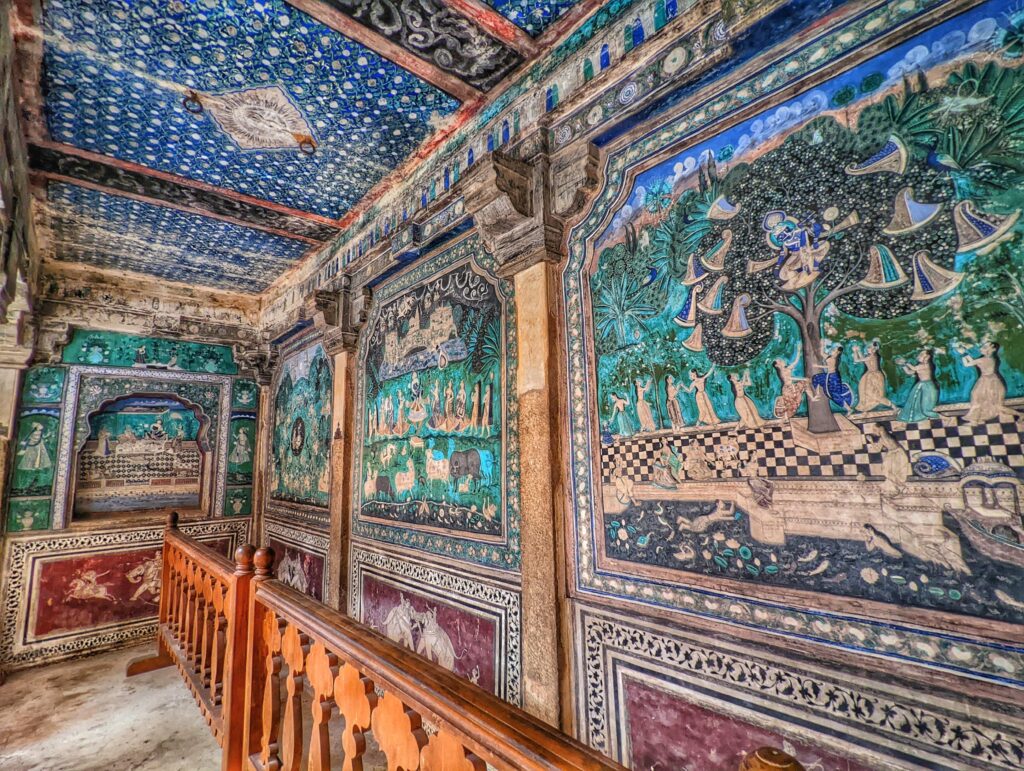
Rajasthan HC allows free entry to Bundi’s Chitrashala
Four hundred year old painting Masterpieces for absolutely free 😁!!
Now what more can I say!
Thanks to Rajasthan Highcourt that we all can see this artistic grandeur for absolutely zero Rupees.
Entering Bundi Chitrashala: A Trip Back in Time
As soon as I stepped inside, I felt that the Bundi artists had painted the rich, vibrant history of Rajasthan directly onto the walls.
And The best part about Bundi Chitrashala ? There was no crowd at Bundi Chitrashala, even though the entry is free. It was just me and a couple of foreigners.
If you’re a fan of miniature paintings, Bundi is a gold mine. Dating back to around the 17th century, these paintings originated in the princely state of Bundi, which was part of the larger Mewar region of Rajasthan. These works are not mere flat, two-dimensional illustrations but exhibit depth, vibrancy, and an almost cinematic quality.
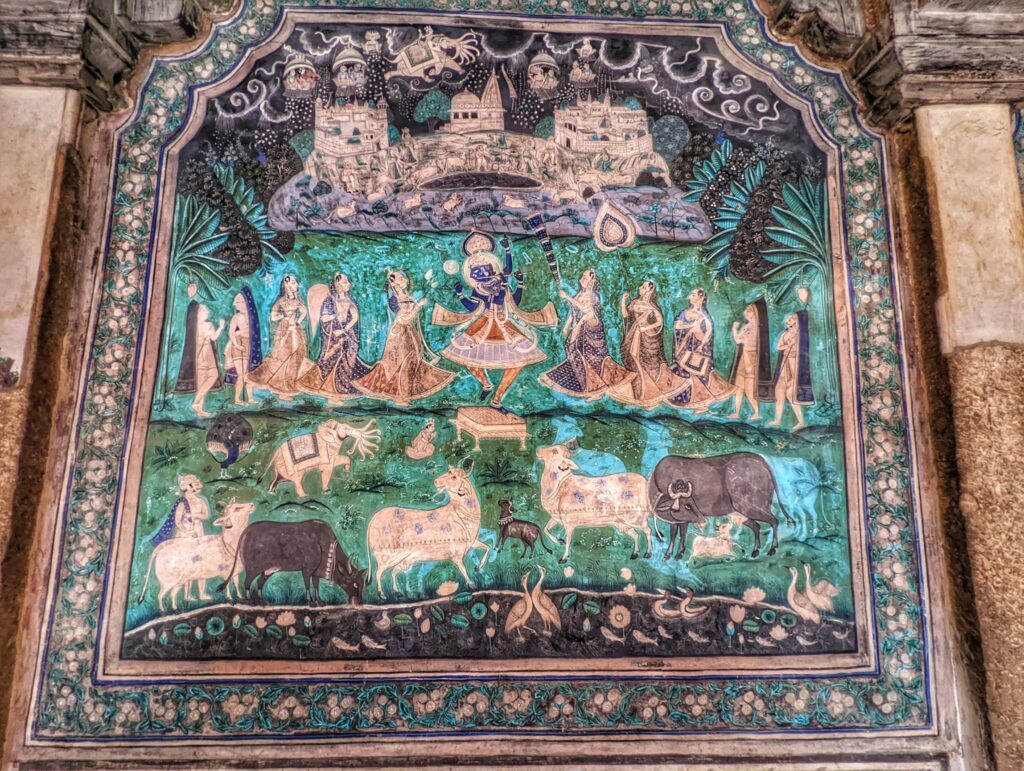
The Unmistakable Bundi Style: A Riot of Colors
As I wandered through the gallery, I was entranced by the use of blue and green hues, which give Bundi art its iconic flair. The delicate floral borders, graceful character poses, and intricate architectural backgrounds add layers of beauty to each mural.The defining feature of Bundi paintings?
The sheer drama in every brushstroke. Imagine Krishna with a background of swooning maidens or lovers meeting secretly under the moonlight, with lush forests, rivers, and flowers painted so vividly that you’d think you could smell the jasmine.
What sets Bundi apart from other schools of painting, like those in Mewar or Jaipur, is the color palette. Where you might expect bold reds and golds, Bundi art leans into earthy, muted greens and blues. These colors convey a sense of calmness, a stark contrast to the fiery tones typically associated with Rajasthani art. It’s almost like a breath of fresh air, a cooling shade under the hot Rajasthani sun.Speaking of colors, Bundi painters mastered the use of cobalt blue, the color of rivers and twilight skies, bringing an unparalleled tranquility to their art.

Landscapes Depicted in Bundi Paintings
When I looked closely, I realized that landscapes are almost as significant as the characters in these paintings. Bundi artists were masters of making environments come alive.Whenever we think of Rajasthan, we picture deserts. However, Bundi artists demonstrate that Rajasthan is not just about deserts—it’s also about green mountains, tall trees, and peacocks wandering during the monsoon.
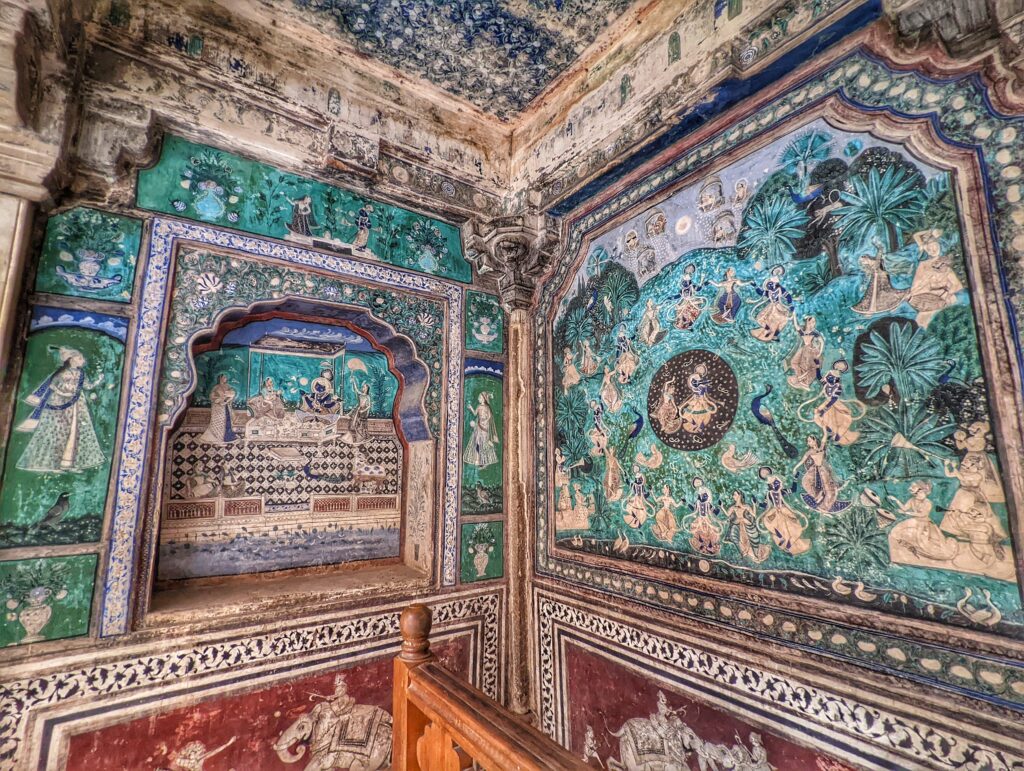
Characters Depicted in Bundi Paintings
Upon entering Chitrashala, the first thing I noticed was the sheer abundance of characters depicted on the walls. The artisans of Bundi have immortalized kings, queens, dancing courtesans, and elephant warriors on these beautiful murals. The paintings portray characters in regal processions, hunting expeditions, and, of course, romantic escapades.
One fascinating detail about these paintings is that almost all the characters are painted in profile, with their faces pointing sideways.
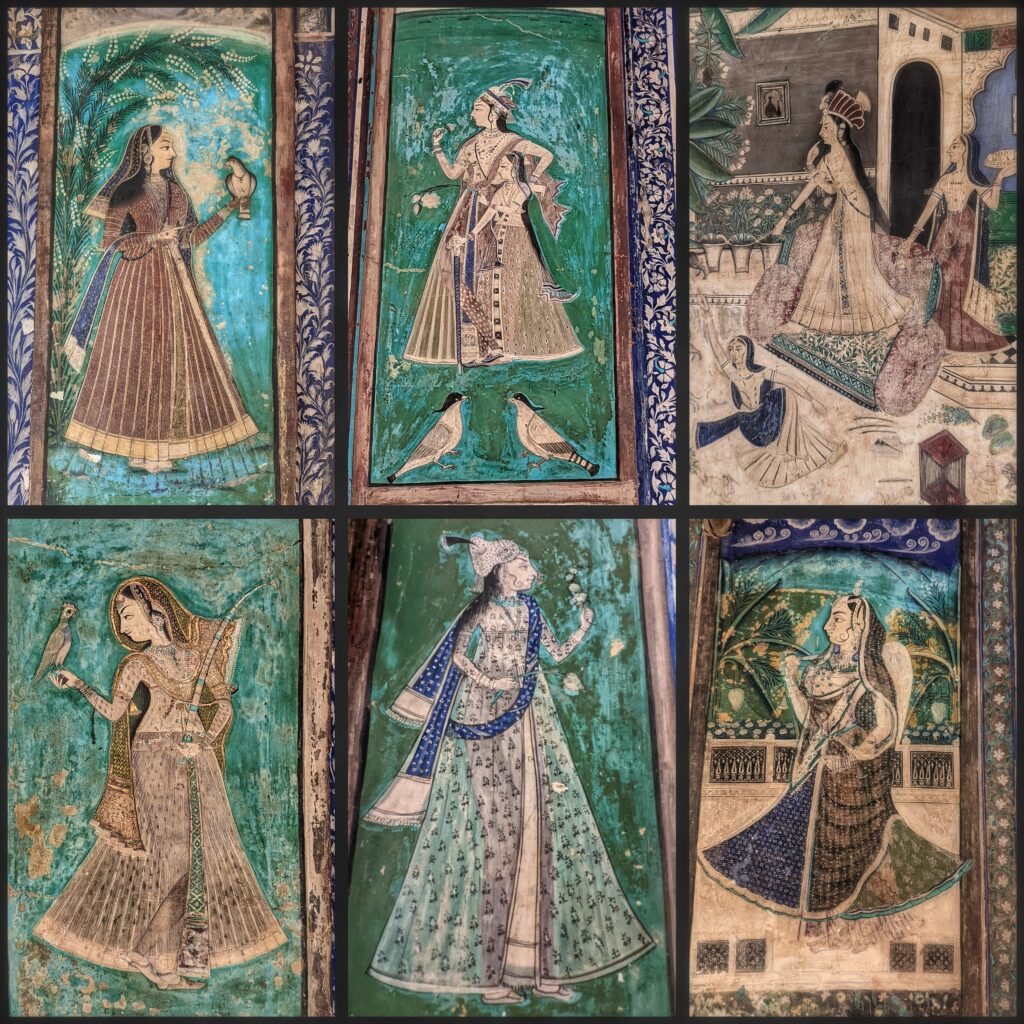
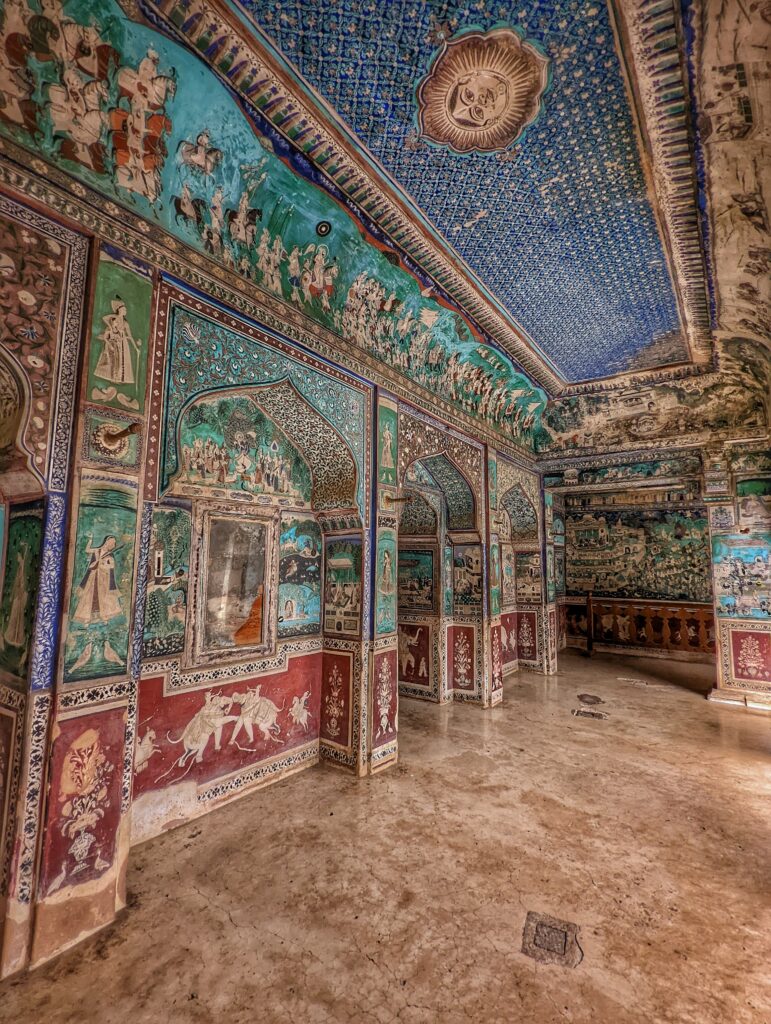
Upon closer inspection, I discovered one exception-a painting on the ceiling featuring a character in a front-facing pose. This unique depiction was of Lord Sun.There are so many characters in these paintings! Even the gods make appearances. Lord Krishna is the undeniable superstar of Bundi paintings, often portrayed alongside Radha and other gopis (cowherd maidens) in lush, idyllic surroundings. Whether lounging with his friends or depicted as a romantic figure, Krishna and the other characters are painted with such delicate lines and expressions that they seem to come alive.
How Bundi style paintings are different from other Rajasthani style paintings?
Bundi Chitrashala stands out from other Rajasthani heritage sites and art hubs due to its unique artistic style, thematic focus, and preservation. Here’s how it differs:
1. Exclusive Bundi School of Painting
Unlike the more widely known Mughal or Mewar schools of painting, Bundi Chitrashala showcases the Bundi school, a distinct art form. Its style is characterized by soft colors, lush landscapes, intricate detailing, and a poetic charm not typically seen elsewhere in Rajasthan.
2. Focus on Nature and Romanticism
While many Rajasthani places emphasize martial themes, grand battles, and royal victories, Bundi Chitrashala’s art focuses on nature, romance, and mythology. The depictions of monsoons, gardens, animals, and birds evoke a serene and lyrical atmosphere.
3. Vivid Mythological Frescoes
Bundi Chitrashala features frescoes heavily inspired by Hindu mythology, especially stories of Lord Krishna, like the Raaslila and other romantic episodes. This thematic depth, combined with intricate detailing, sets it apart from other Rajasthani sites.
4. Unique Use of Natural Pigments
The frescoes in Bundi Chitrashala are painted with natural colors derived from minerals, plants, and other organic materials, giving them a distinctively soft yet vibrant appearance. Many Rajasthani paintings use bright, bold colors, but Bundi’s are subtler and more refined.
5. Completely Uncrowded & serene
Unlike the heavily visited palaces of Jaipur, Udaipur, or Jodhpur, Bundi Chitrashala remains a hidden gem, providing visitors with a peaceful and unhurried experience of Rajasthan’s artistic legacy.
6. Architectural Harmony with Artwork
The Chitrashala is integrated into the Garh Palace, with open galleries and arches that blend seamlessly with the paintings. This combination of art and architecture creates a unique ambiance compared to other standalone art exhibits or galleries in Rajasthan.
7. Delicate Depictions of Seasonal Changes
Bundi’s frescoes often portray seasonal changes, such as monsoons or spring, with intricate details. These depictions, rare in other Rajasthani art, celebrate the connection between humans, nature, and divine elements.
8. Less Restoration, More Authenticity
While some Rajasthani heritage sites have undergone significant restoration, often altering the original art, Bundi Chitrashala retains much of its original charm and authenticity, allowing visitors to experience it as it was centuries ago.
9. Unparalleled Intimacy in Scale
Unlike the grandeur of Jaipur’s City Palace or Udaipur’s Lake Palace, Bundi Chitrashala feels more intimate and personal, focusing on small-scale, intricate art rather than overwhelming grandeur.
10. A Celebration of Everyday Life
The frescoes also include scenes of daily life, courtly pleasures, and festivals, which are portrayed with a delicate touch, making the artwork relatable and human-centric, a less common feature in other Rajasthani heritage sites.
Bundi Chitrashala offers a distinctive perspective on Rajasthan’s artistic and cultural heritage, emphasizing a softer, more poetic vision of life, mythology, and nature that sets it apart from other iconic Rajasthani destinations.
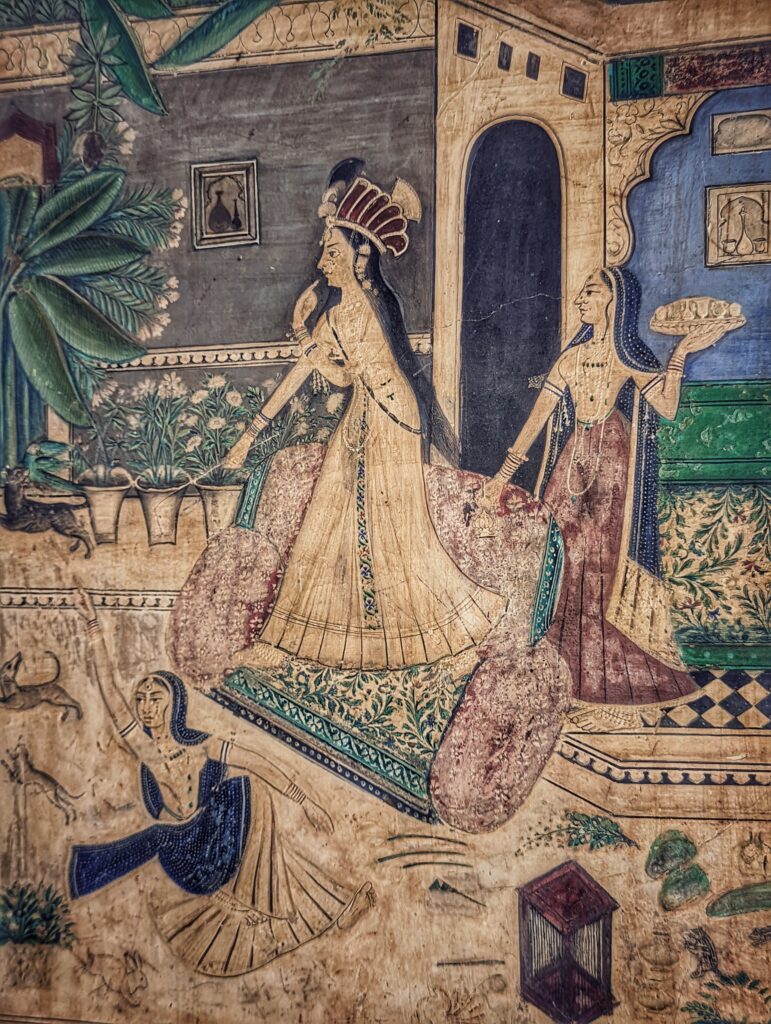
Why Are Bundi Paintings an Epitome of Indo-Islamic Art?
Disclaimer: The following explanation is detailed and best suited for hardcore art and history enthusiasts.
The Bundi school of painting is celebrated for its unique blend of Rajput aesthetics and Mughal influences. While Bundi art initially flourished with traditional Rajasthani styles, the Mughal influence introduced a fresh perspective that subtly but significantly transformed the region’s visual language.
One noticeable Mughal influence was in the depiction of nature. Mughal art is renowned for its delicate portrayal of flora, fauna, and natural landscapes, a style Bundi artists eagerly adopted. Unlike the flat, symbolic forms of traditional Rajasthani art, Mughal-inspired landscapes included realistic and atmospheric details, evident in Bundi’s lush green forests, winding rivers, and rolling hills.
The Mughal influence also enhanced the portrayal of human figures. Their focus on portraiture and fine details inspired Bundi artists to depict human emotions and individual personalities with subtlety. Royal figures, divine beings, and even common folk were painted with carefully rendered facial expressions and gestures that conveyed emotion, status, and individuality.
The Mughal preference for subdued, earthy colors also impacted Bundi’s color palette. While traditional Rajput art favored bold reds, yellows, and golds, Bundi artists incorporated softer tones like cool blues and greens. This shift created tranquil, meditative scenes, especially in monsoon themes—a recurring favorite in Bundi paintings.
Finally, Mughal techniques in composition and perspective enabled Bundi artists to craft intricate and layered storytelling. Bundi paintings, thus, reflect a seamless fusion of Rajput boldness and Mughal elegance, offering a timeless and harmonious visual experience.
FAQ: Do’s and Don’ts in Bundi Chitrashala

1. What are the main do’s when visiting Bundi Chitrashala?
- Respect the artwork: The murals and paintings are delicate and of immense cultural value.Follow guided tours: These offer valuable insights into the art and history of the place.
- Observe silence: Appreciate the intricate details of the art without disturbing the ambiance.
2. Are there specific don’ts while visiting Bundi Chitrashala?
- Don’t touch the murals or paintings: The surfaces are sensitive, and touching can cause irreversible damage.
- Don’t bring food or drinks inside: Avoid spills and pests; only carry a water bottle.
- Don’t use flash photography: Flash can damage the ancient murals, so stick to non-flash photography if permitted.
- Don’t engage in loud conversations or phone calls: Maintain a peaceful environment for all visitors.
- Don’t leave litter behind: Dispose of trash responsibly or carry it out with you.
3. Is photography allowed in Bundi Chitrashala?
Non-flash photography is permitted.
4. Can I bring children to Bundi Chitrashala?
Yes, but supervise them closely to ensure the delicate artworks and quiet ambiance are respected.
5. Are there dress code requirements?
While there’s no strict dress code, opt for comfortable, modest clothing. Lightweight clothes and comfortable walking shoes are recommended.
6. Can I hire a guide at Bundi Chitrashala?
Yes, hiring a guide is highly beneficial for gaining deeper insights into the history and significance of the site.
7. What is the best time to visit Bundi Chitrashala?
The best time is during the cooler months from October to March. Monsoon is also a great time to visit.
8. Can I bring art supplies for sketching or painting on-site?
Typically, art supplies are not allowed as they can damage the site. Check with management or guides for specific allowances.
Final Thoughts on Bundi Chitrashala
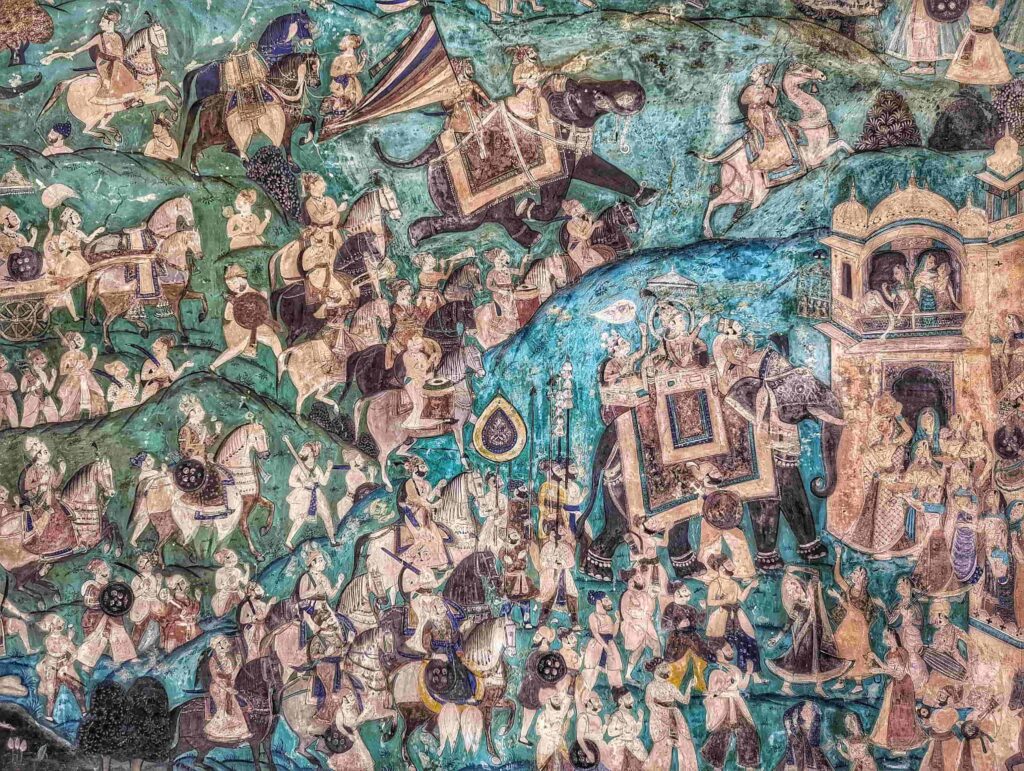
Chitrashala is more than just a gallery. It is narrative masterpiece that showcases the extraordinary talent and vision of Bundi’s artists.Even for someone who isn’t an art critic, Bundi Chitrashala leaves a lasting impression. The depth of storytelling, the vibrant frescoes, and the meticulous craftsmanship demonstrate a level of artistic brilliance that stands the test of time.
Whether you’re an art lover, a history enthusiast, or simply a traveler seeking hidden gems, Bundi Chitrashala promises an unforgettable journey into the heart of Rajasthani culture and heritage.
Have you experienced the mesmerizing beauty of Bundi Chitrashala? Did the vibrant frescoes and intricate details captivate you, or did a particular story on the walls leave you inspired? Share your favorite moments, tips, or travel questions below!


[…] paintings? For a deeper dive into the enchanting world of Bundi art, check out our detailed blog on Bundi Chitrashala and discover more of these stunning […]
[…] Complete Travel Guide to Bundi Chitrashala in 2025: Explore Miniature Painting Masterpieces from Raj… […]
[…] Complete Travel Guide to Bundi Chitrashala in 2025: Explore Miniature Painting Masterpieces from Raj… […]